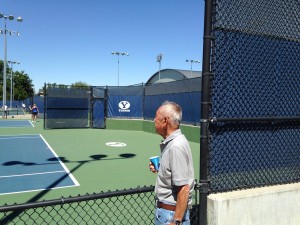
BYU currently has more than 500 athletes in more than 20 sports teams. The campus only hosted one team when Francis Itaya arrived in 1942.
Itaya grew up in Los Gatos, California, and played tennis through high school, winning several regional championships. His career came to a halt when the United States entered World War II, and he was forced to move to the Heart Mountain Internment camp in Wyoming with his brother and mother due to his Japanese heritage.
“It was like an army camp,” Itaya said. “They had a barbed wire fence, and we slept in army barracks. I was there for a little over a month.”
Itaya applied to several colleges, including BYU, Snow College and the University of Colorado, in hopes of gaining a pass out of the camp.
“I got the first reply from BYU. They accepted students from Heart Mountain,” Itaya said. “I went because I wanted to get out of camp.”
Itaya left for Utah with his mother, who worked for a family in Salt Lake City while Itaya attended school in Provo. Itaya majored in political science and sociology.
Itaya continued his tennis career when he came to BYU, playing in both 1942 and 1943.
“The first year, I played second singles,” Itaya said. “We got beaten by Utah in the finals. My second year, Chauncey Peterson was No. 1; I was No. 2. Chauncey and I would beat the Lewis brothers for the first doubles championship.”
BYU budget limitations left the team with far less equipment and space than the team has now; BYU only had three tennis courts at the time, compared to 16 courts today, including four indoor courts.
“We used wooden racquets. We didn’t have graphite or ticonium or anything,” Itaya said. “We get one racquet per season, and one restring job, and a t-shirt. All my life, I’d never had a free racquet until I came to BYU.”
Itaya remembers feeling somewhat under-equipped against the larger, better-funded U of U team.
“Utah had better stuff, like sweats and racquet covers,” he said. “We’d come to play Utah, and we would just have t-shirts and pants, and the Utah guys had sweats, matching shoes and all the good stuff. We never had that kind of funding.”
Men’s tennis was BYU’s only sports program at the time due to war efforts. This meant that the prime gathering spot for Cougar sports fans was the tennis court.
“Baseball was out; basketball was out; so we were the only ones that had any sports,” Itaya said. “We had good interest from the school.”

BYU beat Utah in the 1943 regional championships in singles and doubles, the singles score being a close 3-2. Itaya and Chauncey Peterson would beat the Lewis brothers, the U’s starting doubles team, to win the doubles championship.
Tennis was only a part of Itaya’s experience at BYU. Itaya remembers attending classes and talking with professors.
“Our classes were real small when I went to school,” he said. “I had a political science class that only had nine people in it. The professor would sit on a desk and put his feet up on the chair and would talk about everything but poli-sci.”
Just a month after earning a degree and winning the state championships, Itaya was drafted into the U.S. Army.
“The semester ended in May, and I got drafted in June,” Itaya said. “The Army sent me to dental technician school in Denver.”
Itaya remained in Denver until the war ended in 1945. He then returned to California to open a dental technician practice with his wife, Shizuko.
“The war was over, so they discharged me from Denver,” Itaya said. “We did all kinds of repairs. Dentures, partial dentures, crowns and bridges.”
Itaya first met his future spouse in California before leaving for Wyoming.
“I met her in the Santa Anita assembly center in Los Angeles,” Itaya said. “Everyone from Santa Clara valley was gathered. Then everyone was separated. She went to Topaz, and I went to Heart Mountain. We were supposed to stay there until the end of the war. If you were inland or had a pass to work, they let you out.”
Shizuko kept in touch with Itaya, and the two were reunited as students at BYU in Provo.
“I asked to go to BYU, and they let me out,” Itaya said. “She applied to BYU and was a freshman when I was a sophomore”
Shizuko supported Itaya’s tennis career while at BYU, attending the matches and watching the players practice.
“The tennis court didn’t even have bleachers for people to watch,” Itaya said. “Students came out to watch, and my girlfriend came out to watch.”
Itaya returned to BYU campus in June to see what’s changed. 72 years have passed since Itaya defeated the Utes in the state championship.
The new courts, special equipment, added facilities and other changes impressed Itaya, but he was glad to know that BYU still carried the proud tradition of playing, and often beating, the University of Utah.




